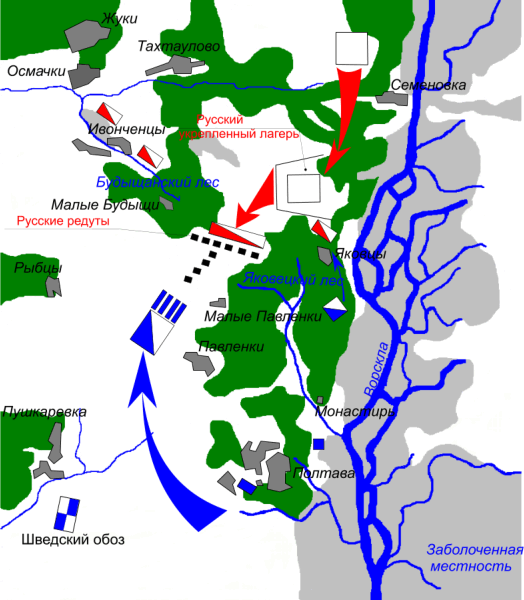|
Battle Of Poltava
The Battle of Poltava took place 8 July 1709, was the decisive and largest battle of the Great Northern War. The Russian army under the command of Tsar Peter I defeated the Swedish army commanded by Carl Gustaf Rehnskiöld. The battle would lead to the Swedish Empire losing its status as a European great power and also marked the beginning of Russian supremacy in eastern Europe. During the course of six years in the initial stages of the war, King Charles XII and the Swedish Empire had defeated almost all participants in the anti-Swedish coalition, which initially consisted of the Polish-Lithuanian Commonwealth, Denmark-Norway and the Tsardom of Russia. The latter, under , was the only one still fighting. Charles therefore chose to invade Russia in the autumn of 1707 and march towards Moscow with a large Swedish army. However, the campaign was complicated by harsh weather conditions and by Russian scorched earth tactics and surprise attacks, which forced Charles to interr ... [...More Info...] [...Related Items...] OR: [Wikipedia] [Google] [Baidu] |
Swedish Invasion Of Russia
The invasion of Russia by Charles XII of Sweden was a campaign undertaken during the Great Northern War between Sweden and the allied states of Russia, Poland, and Denmark. The invasion began with Charles's crossing of the Vistula on 1 January 1708, and effectively ended with the Swedish defeat in the Battle of Poltava on 8 July 1709, though Charles continued to pose a military threat to Russia for several years while under the protection of the Ottoman Empire, Ottoman Turks. Historical context In the years preceding the invasion of Russia, Charles had inflicted significant defeats on the Danish and Polish forces, and Civil war in Poland (1704–1706), enthroned the king Stanisław Leszczyński in Poland. Having consolidated his victories there, he Swedish invasion of Saxony, invaded Saxony, forcing it out of the war. Charles then turned his attentions to Russia. He entered Russia by crossing the frozen Vistula River at the head of 40,000 men, approximately half of them cavalry. ... [...More Info...] [...Related Items...] OR: [Wikipedia] [Google] [Baidu] |
